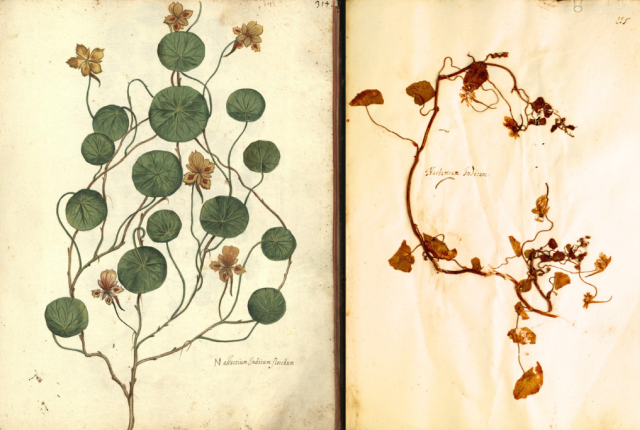The case of the dwarf nasturtium in Italy solved thanks to Ulisse Aldrovandi’ herbarium

The dwarf nasturtium (Tropaeolum minus L.) has been absent from Italy for centuries. The plant, a member of the Tropaeolaceae family, native to South America, has been replaced by the hardier garden nasturtium (Tropaeolum majus L.). However, the dwarf nasturtium was cultivated in our country for a short time and arrived here decades earlier than previously thought.
The key to this discovery was hidden in the pages of the few Renaissance herbaria that have survived to the present day, including that of Ulisse Aldrovandi: held by the University of Bologna and by far the most important in the world.
"The dwarf nasturtium was introduced to Europe around 1570 and was very popular in the first decades of the 17th Century, both as a medicinal and ornamental plant and s an edible vegetable," says Fabrizio Buldrini, a botanist from the Department of Biological, Geological and Environmental Sciences at the University of Bologna, who led the study. "In Italy, until now, its introduction was dated back only to 1642, but recently a number of clues have suggested that it could have been introduced earlier than the late 16th Century.
These clues come mainly from the study of ancient herbaria, the very first collections of dried plants made for study purposes, dating back to the 16th Century. Today, three of the nine ancient herbaria known in Italy, of about twenty Renaissance herbaria existing in the world, are kept in the university Herbarium. This extremely valuable heritage makes the University of Bologna, with the Department of Biological, Geological and Environmental Sciences and the University Museum System, a unique centre for this type of historical and botanical research. The study of ancient herbaria requires the combination of very different skills - flora, systematics, the history of science, the Latin language, codicology, philigranology - and this is made possible by the University's distinguished background in botanical studies and the heritage of historical herbaria kept at our University.
For example, research into the dwarf nasturtium (Tropaeolum minus) has revealed traces of the plant's presence in Italy as early as the late 16th Century.
"The dwarf nasturtium was certainly present in Bologna, Genoa, Florence, Rome and Pisa in the last three decades of the 16th Century," explains Fabrizio Buldrini. "We can assume that the plant arrived in Italy between 1567 and 1570: its cultivation must have begun no more than ten years later, but it was probably not very successful".
In fact, the dwarf nasturtium has spread easily in the central areas of Europe with a continental climate, while it is much more difficult to grow in northern and Mediterranean regions. Scientists therefore speculate that after an initial spread as a rarity from the West Indies, the dwarf nasturtium was replaced by the hardier and more colourful garden nasturtium (Tropaeolum majus).
"Researching and documenting changes in plant biodiversity over time allows us to reconstruct a botanical memory useful for interpreting current trends influenced by global change," adds Fabrizio Buldrini. "Ancient herbaria and their study have an irreplaceable role to play in this respect".
In this sense, Ulisse Aldrovandi’s herbarium is undoubtedly the most important of the three Renaissance herbaria kept in Bologna. Dating from 1551 to 1586, it is a unique document in terms of its age, the number of species present, the precision and richness of the nomenclature, and the note of the locations where the samples were collected. Aldrovandi collected plants systematically and with such a scientific approach and mentality that we can use the catalogued material almost as if it had been collected in the present day.
The results of the study on the dwarf nasturtium (Tropaeolum minus) were published in Rendiconti Lincei. Scienze Fisiche e Naturali under the title 'Redating the arrival of Tropaeolum minus in Italy'. The authors are Fabrizio Buldrini and Umberto Mossetti from the University of Bologna, together with Juan Francisco Morales from the University of the West Indies (Trinidad and Tobago).
.






